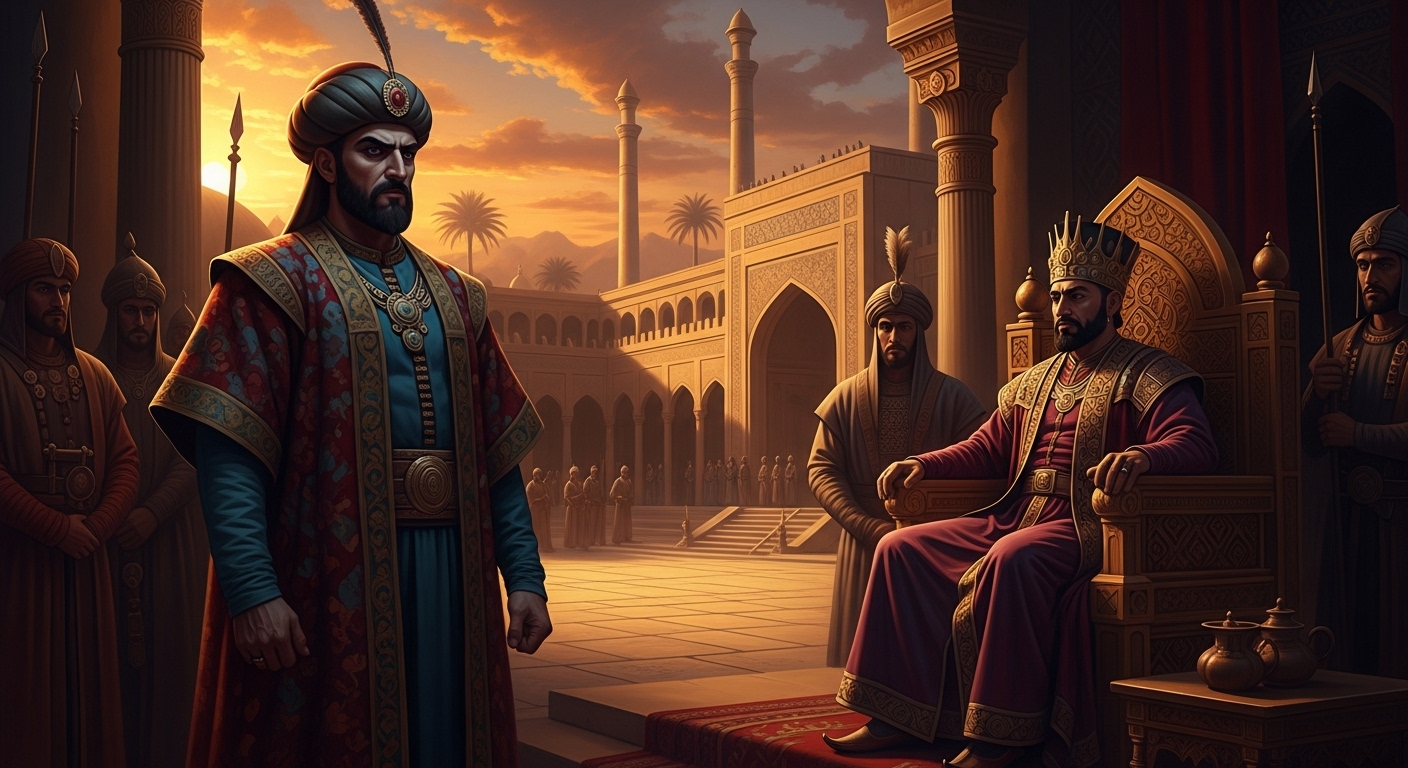Haman: The Enemy Of God In Esther’s Narrative

Introduction
Have you ever met someone who seemed determined to destroy what God was protecting? In Esther’s story, you’ll find a man whose ambition and hatred set him against God’s people—and, in a very real sense, against God’s purposes. You might not live in a palace or face a plot to annihilate a nation, but the dynamics at play—pride, manipulation, scapegoating, and divine reversal—are alive in workplaces, families, and online communities today.
In this article, you’ll walk through the Bible’s portrait of Haman as the Haman Enemy of God, see why that label matters, and learn how the ancient account speaks directly to your faith, your decisions, and your courage. You’ll also get practical steps to stand for justice and peace when you face opposition that feels spiritual in nature. Let’s start by seeing what the Scripture actually says.
The Bible Foundation
Chosen passage: Esther 3:1–15 (NIV)
Esther 3:1–15 (NIV) 1 After these events, King Xerxes promoted Haman son of Hammedatha, the Agagite, and advanced him and set his seat above all the nobles who were with him. 2 All the king’s servants at the king’s gate knelt down and paid homage to Haman, for the king had commanded; but Mordecai would not kneel or pay him homage. 3 Then the king’s servants at the gate said to Mordecai, “Why do you transgress the king’s command?” 4 When they spoke to him day after day and he refused to listen, they told Haman to see whether Mordecai’s behavior would stand; for he had told them that he was a Jew. 5 When Haman saw that Mordecai would not kneel or pay him homage, Haman was enraged. 6 But he disdained to lay hands on Mordecai alone; for they had told him of Mordecai’s people, and Haman sought to destroy all the Jews who were throughout the whole kingdom of Ahasuerus— the people of Mordecai. 7 In the first month, which is the month Nisan, in the twelfth year of King Ahasuerus, they cast Pur (that is, they cast lots) before Haman from day to day and from month to month until the twelfth month, which is the month Adar. 8 Then Haman said to King Ahasuerus, “There is a certain people scattered abroad and dispersed among the peoples in all the provinces of your kingdom; and their laws are different from those of every people, and they do not keep the king’s laws; therefore, it is not for the king’s profit to tolerate them. 9 If it pleases the king, let it be written that they may be destroyed; and I will pay ten thousand talents of silver to the hands of those who have charge of the business, to bring it to the king’s treasuries.” 10 So the king took his ring from his hand and gave it to Haman the son of Hammedatha, the Agagite, the enemy of the Jews. 11 And the king said to Haman, “The money is given to you, and the people also, to do with them as seems good to you.” 12 Then the king said to the scribes who wrote the king’s edicts, “Write as it is written to the king, and seal it with the king’s ring.” So the decree was written according to all that Haman commanded to the king’s satraps and to the governors who were over every province; and to the princes who were over every people; and to the officials of every province in their own script, and to the people in their own language, that every people might be ready for that day. 13 The letters were sent by couriers into all the king’s provinces to annihilate, to kill, and to destroy all Jews, both young and old, women and children, in one day, the thirteenth day of the twelfth month, which is the month Adar, and to plunder their goods. 14 A copy of the writing of the decree was given to Haman, who had the charge of bringing the money to the king’s treasuries; then the king and Haman sat down to drink, but the city of Susa was bewildered. 15 When Mordecai learned of all that had been done, and of the decree that had been issued, he tore his clothes and put on sackcloth with ashes, and went out into the midst of the city and cried with a loud and bitter cry;
What’s happening here is clear and shocking: Haman rises to power, expects universal honor, and when one man (Mordecai) refuses to bow out of conscience or covenant, Haman explodes in hatred. He moves from personal offense to political genocide. The text even calls him “the enemy of the Jews” (v.10), which in the story becomes the same as being an enemy of God’s people and God’s purposes. For an 8th grader: Haman got angry when someone wouldn’t worship him, and instead of dealing with that honestly, he decided to get rid of everyone who belonged to the person he was mad at. That’s dangerous pride and scapegoating.

Understanding the Core Truth
At the heart of this section of Esther is a simple, yet profound truth: evil often presents as personal humiliation turned into public harm. Haman’s inner pride became a political program. The core message you should take away is that unchecked pride, dehumanization, and the misuse of power become tools the enemy uses to oppose God’s people and plans.
“Haman Enemy of God” isn’t just a label of history; it’s a spiritual category that points to how opposition to God’s will frequently hides behind ambition, fear, or the desire to control. You can recognize the pattern: when someone treats others as expendable to protect their reputation, that’s where God’s people must pay attention and respond wisely.
Going Deeper — The Hidden Meaning

When you dig deeper, the story shows God’s hidden hand even when God’s name never appears in the book of Esther. The hidden meaning is twofold: first, God preserves His people through human courage, prayer, and faithful risk; second, God uses the very plots of the proud to bring about reversal.
Haman thought he had all the cards—royal favor, sealed decrees, wealth. Yet the narrative turns him from the one who would hang Mordecai into the man hanged on his own gallows (see Esther 7:9–10). That reversal is not just poetic justice; it’s theological: God’s justice penetrates human scheming. For your life, that means the enemy’s designs are not ultimate. The Lord can work behind the scenes even when you don’t see it. Remember Joseph’s reversal in Genesis, and how exile and suffering became channels for God’s larger plan (Genesis 50:20). These patterns invite you to trust that God often works in “hidden” ways through prayerfulness, courage, and truth-telling.
Modern Connection — Relevance Today

Haman’s story is surprisingly modern. You see him in the workplace bully who grooms leaders, in political scapegoating that paints entire groups as “other,” and in social media cancel culture that dehumanizes people. The “Haman Enemy of God” pattern shows up whenever someone’s wounded pride becomes a campaign against the vulnerable.
For you, this means watching for signs: does a conversation turn into broad labels and dehumanizing language? Are policies proposed that hurt entire groups for the sake of a few people’s anger? Recognizing the pattern helps you intervene with courage—by speaking truth, protecting the vulnerable, and calling out unjust misuse of power. The Esther story gives you a model: wise courage hiding at first (Esther’s faithfulness), strategic advocacy (Mordecai’s persistence), and spiritual reliance (fasting and prayer) all work together.
Practical Application — Living the Message
You don’t need to be a queen to stand against a Haman in your world. Here are practical, doable steps you can take:
- Notice and name dehumanization. When someone’s language or policies reduce people to caricatures, call it out calmly and clearly. Use facts and stories to humanize those targeted.
- Protect the vulnerable. Support those endangered by unjust systems—advocate, mentor, give resources, or report wrongdoing when necessary.
- Pray and act together. Like Esther and Mordecai, combine spiritual reliance (prayer, fasting, listening to God) with concrete action (talking to the right people, mobilizing help).
- Keep your pride in check. Test your motives: are you protecting people or your reputation? Haman’s tragedy begins with self-exaltation—stay humble.
- Build alliances. Few battles are won alone. Find friends, mentors, and leaders who will stand with the vulnerable and speak truth to power.
These steps help you live Esther’s lessons in tangible ways. You’ll be less likely to be intimidated by the “Haman Enemy of God” dynamics and more equipped to be part of God’s restorative work.
🌿 Faith Reflection Box
Take a moment. Where have you seen pride become a campaign against the vulnerable? What small next step can you take to protect dignity and speak truth in love?
Key Takeaways:
- Haman models how pride and power become spiritual opposition; recognize the pattern.
- God’s sovereignty means reversals are possible; trust hidden providence.
- Combine prayer, humility, and action—like Esther and Mordecai—to protect the vulnerable.
- Speak truth, humanize the targeted, and form alliances for justice.
Q&A
Q1: Is Haman literally “the enemy of God”?
Answer: In the narrative, Haman is called the enemy of the Jews (Esther 3:10), and because God’s covenant and purposes are embodied in His people, opposing God’s people is, in effect, opposing God’s plans. That doesn’t mean Haman is beyond hope biblically, but the text portrays his actions as hostile to God’s kingdom. In the broader biblical view, opposition to God’s redemptive work—through violence, deceit, or pride—positions people against God (see Romans 1:18-21).
Related: Why Does God Allow Suffering? (https://biblestorieshub.com/why-does-god-allow-suffering-romans-828/)
Q2: Why doesn’t the book of Esther mention God’s name?
Answer: Esther is notable for never using God’s name directly, which many scholars say heightens the sense of “hidden” providence—God is working behind the scenes through people’s choices. The book emphasizes human responsibility (Esther’s courage, Mordecai’s faith) and divine control without explicit theophany. This invites you to trust God even when His action isn’t obvious. See Esther 4 and Romans 8:28 (Romans 8:28) for the theme of God working in hidden ways.
See also: Daily Prayers for Strength in Difficult Times (Psalm 46:1) (https://biblestorieshub.com/daily-prayers-for-strength-in-difficult-times/)
Q3: What can you do when someone in power acts like Haman?
Answer: Respond with wisdom. First, protect those at risk. Second, gather allies and document injustices. Third, use truthful advocacy rather than retaliation. Finally, stay spiritually centered with prayer and community support. Scripture supports active, righteous resistance to injustice (Proverbs 31:8-9; see Proverbs 31:8-9) while calling you to humility and discernment so you don’t mirror the oppressor’s methods.
Q4: How does Esther’s courage teach modern believers about confronting evil?
Answer: Esther shows you that courage often includes risk and strategy. She fasted and prayed and then spoke at the right moment (Esther 4–5). Your courage might look like a quiet intervention, a public testimony, or a prayerful conversation. The key is linking spiritual dependence with concrete action. Jesus taught this combination—faith expressed in works (James 2:14-17; see James 2:14-17).
Conclusion & Reflection
Haman’s story is a sober reminder that the enemy’s tools are often ordinary human sins—pride, envy, and the hunger for recognition. But Esther also shows you the other side: God uses unlikely people, hidden prayers, and moral courage to turn plots inside out. If you’re facing Haman-like opposition—someone using power to harm—remember that God’s sovereignty and your faithful action belong together. Stand for the vulnerable, pray without ceasing, and act with humility and wisdom.
A simple prayer you can say now: Lord, give me courage to stand for justice, humility to examine my heart, and wisdom to act in ways that honor You. Protect those who are vulnerable and use my life for Your purposes. In Jesus’ name, Amen.

More Inspiration Awaits — Read These Next
👉 For deeper insight into Isaiah 40:31 and how it renews your strength in both faith and daily life
👉 For practical lessons on compassion and neighborliness from the Good Samaritan
👉 For a clear explanation of what we can learn from the Parable of the Good Samaritan
👉 For meaningful insights from the Parable of the Pearl and its hidden treasures
👉 For a deeper look at the Rich Man and Lazarus and what it reveals about the afterlife
👉 For guidance on the Parable of the Ten Virgins and preparing for God’s Kingdom
👉 For clarity on the Parable of the Lamp and how it calls us to shine our light
👉 For insights from the Parable of the Wedding Feast and the meaning behind the invited guests

📘 Jesus and the Woman Caught in Adultery – Grace and Mercy Over Judgement
A powerful retelling of John 8:1-11. This book brings to life the depth of forgiveness, mercy, and God’s unwavering love.
👉 Check it now on Amazon 🛒💥
🔥 “Every great message deserves a home online.” 🌍💬🏡
Don’t let your calling stay hidden. Start a Christian blog or website using Hostinger — with 99.9% uptime, a free domain, and SSL, your voice can shine for God’s glory anytime, anywhere.
💥 Begin today. 🛒 Try it RISK-FREE! ✅
✝️ “Your body is God’s temple — care for it with purpose.” 💪💖🏛️
Renew your energy and restore balance naturally. Mitolyn helps support a healthy metabolism, giving you the vitality to live out God’s calling with strength and confidence.
🔥 Unlock Your Metabolic Power! ⚡Burn More Calories & Feel Great With Mitolyn. 💪
👉 Start Today. 🚀 Check Price Now. 🛒💰
💰 As a ClickBank & Amazon Affiliate, I earn from qualifying purchases.
📖 Acknowledgment: All Bible verses referenced in this article were accessed via Bible Gateway (or Bible Hub).
🚀 Want to explore more? 👉 Dive into our new post on Why Jesus? and experience the 🔥 life-changing truth of the Gospel!








